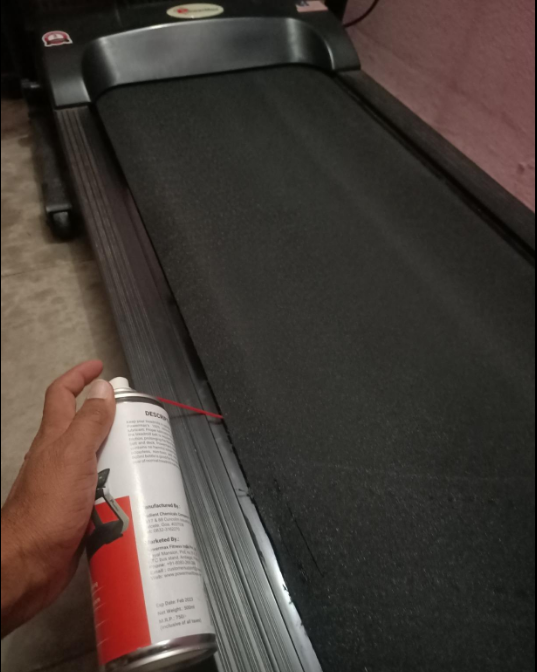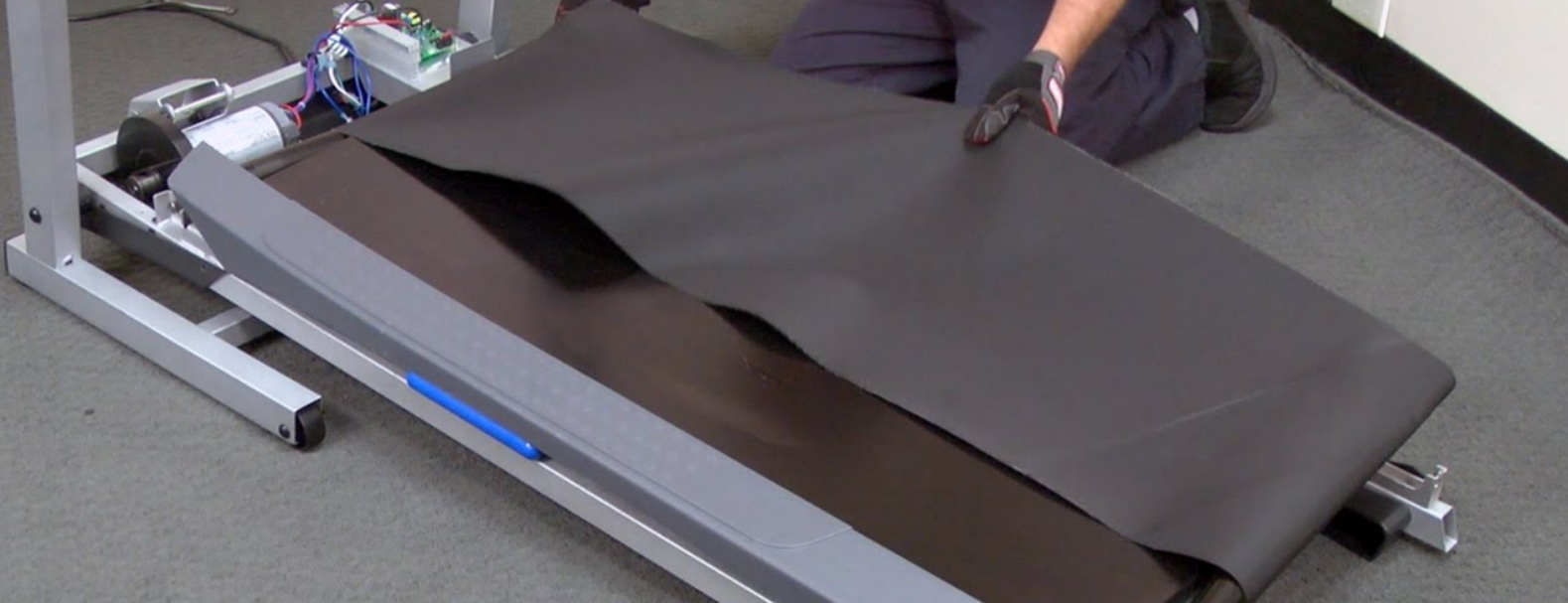Are you tired of slipping and sliding on your treadmill while trying to get a good workout? Or is your treadmill belt slipping to one side? Don’t let a slipping treadmill belt ruin your exercise routine.
If the treadmill shifts to one side or stops whenever you step on it, this may be a problem with the belt. Other symptoms include wear and tear of the belt, wobbliness of the belt, or jerk or slip as well. You might hear unusual grinding noises as well.
Luckily, adjusting your treadmill belt is a simple and safe process that can be done in just a few easy steps. In this article, we will guide you through the identification of a slipping treadmill belt and show you how to adjust it properly.
From improper belt tension to insufficient lubrication, I will cover it all. Say goodbye to the frustration and danger of a slipping treadmill belt and hello to a smooth and safe workout.
Why Your Treadmill Belt Might Be Slipping?
Treadmill Belt slipping is a common issue and even I have faced this issue with my NordicTrack Commercial 1750. This was so frustrating and even stopped me from running on my treadmill for a few days. But then luckily I found some stops to fix these problems which I will mention below.
However, for now, I will share some causes of why a treadmill belt slips:
1. Improper belt tension
If your treadmill’s belt is too loose, it can make the treadmill belt slip when you are walking or running on the treadmill. This can occur due to normal wear and tear, lack of maintenance, or improper adjustment. When the running belt is loose, it can slip or jerk, making it difficult to walk or run on the treadmill.
On the other side, a too-tight treadmill belt could damage the engine, rollers, and belt. As a result, the motor could overwork and eventually burn out.
Check the screws twice to make sure they aren’t overtightened. Anyone using the treadmill might find this to be too hazardous because it could result in serious injury.
2. Incorrect alignment
A treadmill belt can slip due to poor alignment. While you are working out, the belt could break loose if the rollers and pulley are not lined up. If you want to safely jog or walk on your treadmill, alignment is essential!
Check the alignment if you experience belt slipping when jogging on a treadmill. You might find the treadmill a bit jiggly or wobbly because of the incorrect adjustment. Running or walking on a treadmill that is not correctly positioned is dangerous.
3. Worn-out belts
A belt that is worn out is another common reason why a treadmill belt slips. If the belt is old, worn out, or has been used regularly, it may begin to slip. The belt may have worn out over time, required poor maintenance, or perhaps just been used frequently.

The belt should be frequently inspected for wear indicators and replaced as necessary. Avoid exercising on the treadmill vigorously, and keep it maintained as directed by the manufacturer.
4. Insufficient lubrication
I tried to mention every cause why a treadmill belt might be slipping. However, the only cause left is that your treadmill belt might be slipping and that the underside surface of the belt is not getting enough lubrication.
If you don’t lubricate your treadmill, there will be reduced friction between the belt and the deck. If there is not enough lubrication, the belt can slip.
This can be due to a variety of factors such as the frequency of use, the type of lubricant used, or the age of the machine.
As we all know, lubrication is necessary for any machine to work properly. If your treadmill is not lubricated it will make unusual noises or get stuck suddenly.
Also, read:
- Tired of the Treadmill Squeaking? Here’s How to Fix It!
- Why Does My Treadmill Keep Stopping? How To Fix?
How To Diagnose Treadmill Belt Slipping?
A treadmill is really important for your fitness and better pulse rate. Well, you won’t like it if you are slipping on your treadmill belt.
In that case, diagnosing the underlying problem as soon as possible will help you avoid these and other potential issues with your treadmill’s belt.
Here are some steps to diagnose a treadmill slipping belt:
1. Check the Tension of the Belt
To fix a slipping treadmill belt, the tension must be checked first. A loose belt may slip during use, so turn off the treadmill and unplug it before lifting the belt from the center to measure the gap between the belt and the deck.
The ideal gap is 1/8 to 1/4 inch, and if it’s larger, adjust the tension following the manufacturer’s instructions.
2. Inspect the Belt and Deck
You obviously won’t want to slip or trip off a treadmill. You must take certain safety measures for that.

Make sure to inspect the belt and deck for signs of wear and tear. It might not offer enough grip if the belt is frayed or worn out, or if the deck is broken or worn out.
Remove the belt and inspect the deck for cracks or fraying while inspecting the belt for grooves. It must be replaced if either is harmed.
3. Lubricate the Belt
When the belt and deck are in good shape and the tension is right, a lack of lubrication can cause the belt to slip. This is because the belt can dry out over time, losing its grip on the deck.

To resolve this, you should lubricate the belt following the manufacturer’s instructions, which usually involves applying a silicone-based lubricant underneath the belt. Make sure to use the appropriate lubricant for your treadmill.
4. Check the Motor
If you have checked everything and less, and you still couldn’t diagnose the main cause. There is one last thing you need to check and that is the motor of the treadmill. A weak motor may be unable to offer enough power to keep the belt running efficiently.
To check the motor, turn off the treadmill, unplug it, and remove the motor cover. Check for any signs of wear or damage, and if it’s ruined, replace it.
You may also like to read:
- What Is The Ideal Treadmill Running Speed? [Different Age Groups]
- How Heavy Is A Treadmill? How Much Does A Treadmill Weigh?
How To Fix a Slipping Treadmill Belt?
Because using a treadmill is a great way to stay in shape and stay healthy, I am aware of how much you dislike it when the belt starts to slip. You could get hurt if you lose your balance on it, which makes it risky to walk or run on as well.
Don’t worry!
I’ll tell you how to fix a slipping treadmill belt in the simplest possible ways.
1. Turn off the treadmill and unplug it
So, In the start, you need to turn off your treadmill before you make any sort of adjustments.
2. Check the belt tension
Find the belt tension adjustment bolts on the back of your treadmill after it has been turned off. To tighten the nuts and change the belt tension, use an Allen wrench. A tight belt can harm the treadmill, so be careful not to over-tighten it.
3. Lubricate the belt
A slipping belt can be caused by friction from a lack of lubrication. Apply a silicone-based lubricant to the belt’s underside while it’s still moving slowly to lubricate it. Make sure the belt is covered evenly.
4. Check the belt condition
Look for any wear or damage on the belt. It’s time to change the belt if it has any cracks or tears. Slide the belt off the rear roller before removing the front roller to replace it. Reattach the front roller after replacing the belt.
5. Adjust the drive belt
If the drive belt is having problems, the belt tension may be fine. Find the drive belt and see if it’s worn out or loose. If so, change it or adapt it appropriately.
Loosen the bolts holding the motor in place, then slide it closer to the front roller to adjust the driving belt. Reinstall the bolts and tighten them.
6. Check the drive roller
The belt and the motor are moved together by the drive roller. If it is worn out, the belt may slip as a result. Look for wear on the driving roller and replace it if necessary.
7. Finally, test the treadmill
Test the treadmill at a slow speed to verify sure everything is in working order after making the necessary adjustments and resolving the slipping problem.
[/alert-warning]
How To Prevent the Treadmill Belt From Slipping?
A treadmill belt can slip or even get stuck in some cases, and you will have to fix your treadmill in that case. But wouldn’t it be great if your treadmill doesn’t even have an issue like a belt slipping?
Well, anyone would love that. For that, you will have to put in some effort and let me guide you on all the ways of preventing treadmill belt slipping:
Adjust the belt tension
Checking the belt tension is the first step in avoiding your treadmill’s belt from slipping. If the belt is too slack, it may slide or even come to a complete halt.
You must find the tension bolts on the treadmill’s back to alter the tension. To tighten the belt, turn these bolts counterclockwise with an Allen wrench.
After making modifications, check the belt tension to make sure it isn’t overly tight, which could harm the treadmill’s engine and other components.
Clean the belt
Let me tell you something that may surprise you: dirt and debris buildup might result in a belt that slips. Because of this, it’s essential to routinely clean the belt to stop it from slipping.

To remove any filth or debris, use a damp cloth or a cleaning kit; however, stay away from using abrasive cleaners that can harm your property. You can keep your treadmill belt clean and prevent slippage by following these easy instructions.
Lubricate the belt
Your treadmill’s belt can also slip due to insufficient lubrication. Thus, I would recommend you lubricate the belt using a silicone-based lubricant. Apply the oil to the underside of the belt as instructed by the manufacturer.
you avoid getting oil on the rollers or other components of the treadmill, make sure you wipe up any excess.
Check the rollers
Your treadmill’s rollers may potentially be a factor in the belt slipping. The belt may slip or even fall off the track if the rollers are worn or unclean. Check the rollers frequently and clean them as necessary to avoid this. It could be necessary to replace the rollers if they are worn.
Check the motor
In the end, the belt slipping on your treadmill may also be a result of the motor. The belt may slip if the motor is incapable of maintaining the proper speed due to weakness or damage. It is preferable to have the motor inspected by a specialist if you suspect a problem.
Also, read:
FAQs:
How to fix the treadmill belt slipping to one side?
To fix a treadmill belt slipping to one side, use a wrench and a 5/16 hex bit to make quarter turn adjustments to the roller on the slipping side while the treadmill is on a low speed. After each adjustment, let the treadmill run for a while and check if the belt stays straight. Continue making adjustments until the belt is even, level, and straight.
What does a treadmill belt slipping feel like?
If your treadmill belt is slipping, you may feel a sudden jerk or slip, notice an uneven stride, hear a squeaking or grinding noise, and feel the belt is loose or wobbly. It's important to address these symptoms immediately to prevent further damage to the machine and ensure your safety while working out.
How serious is a loose treadmill belt?
The safety of the user and the durability of the machine may both suffer from a loose treadmill belt. Loss of performance, discomfort, and even damage to electrical components might result from the belt's looseness. Maintaining the correct belt tension is essential, with no more than 2-4 inches of lift off the running deck. In order to prevent risks and costly repairs down the road, routine maintenance inspections are crucial.
How many hours should the treadmill belt last?
The average lifespan of a treadmill belt is approximately 400-500 hours or around 2,500-3,000 miles. However factors such as humidity and temperature can affect the lifespan of the belt. For instance, high humidity and heat may shorten its lifespan, while low humidity and cold temperatures can extend it. It's important to keep these factors in mind when determining how long your treadmill belt should last.
Conclusion
There’s nothing worse than a treadmill belt slipping during your workout routine. I understand the frustration and safety concerns that come with this issue.
However, by following the steps I have outlined for diagnosing and fixing a slipping treadmill belt, you can ensure a smooth and safe workout every time.
Remember to check the tension, inspect the belt and deck, lubricate the belt, and check the motor if necessary. Additionally, taking preventative measures such as adjusting the belt tension, cleaning the belt, lubricating it, and checking the rollers and motor can help prolong the lifespan of your treadmill belt.
Don’t let a slipping treadmill belt affect your fitness goals – take action and get back on track with a smooth and safe workout experience.

